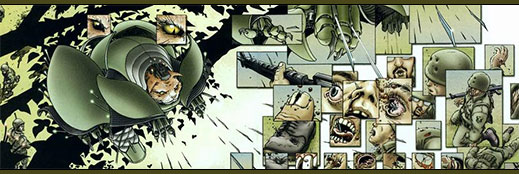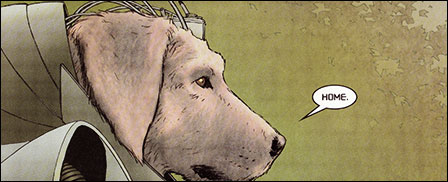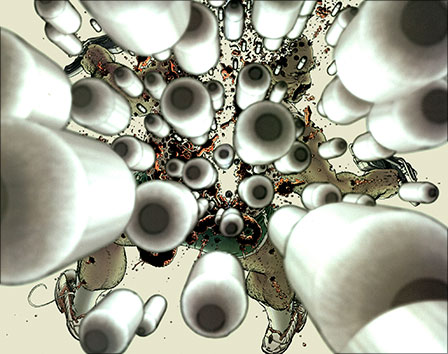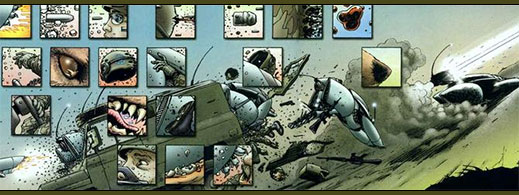WE3
Created by: Grant Morrison and Frank Quitely
Published by: PUBLISHER
ISBN: 1401204953 Amazon
Pages: 108



If you've ever talked with me about Frank Quitely's art, you'll know that I'm not a fan. And I suppose this should be qualified somewhat because in some ways the man does some ridiculously enviable work.
WE3 actually exhibits pretty well where Quitely's weaknesses and strengths lie. His human figures are lumpy, over-saturated bags whose movement is articulated by some awkward skeletal foundation. And yet his page design is sometimes superlative. His faces are alien renderings, where eyes float apart at too-great distances. And yet he can employ the tools of visual storytelling superbly when he wants. His organics are a mess and sit so deeply entrenched in the uncanny valley that extrication seems impossible. And yet his work with non-organics sings, leaping off the page with such unbounded joy that readers may threaten to forget just how terribly his people and animals are conceived.

WE3 demonstrates all of this and it is probably because of how strongly the story relies on Quitely's inventive page design and depictions of technology that I am largely able to forget that the book also contains drawings of people and animals.
Apart from Sea Guy, the absurdist comedy, WE3 is far-and-away my favourite of Grant Morrison's work. It helps that I'm not really a big fan of much of what I've read of the lauded author. I find his ideas intriguing but don't think much of him as a writer. His characters don't usually strike any chord with me, his dialogue is flat, and his storylines are fine but nothing special. So when weighing big ideas against the absence of much of the other stuff required in good writing, I find myself generally pretty nonplussed.
Still, since I love big ideas, I keep returning to his work to see if he gets better at the other stuff that matters. One day, perhaps.

Yep. The animals talk. Well, 1 here talks better than the other two...
WE3 is something of a reimagining of the Homeward Bound-style animal quest storyline with some Plague Dogs thrown in for good measure. Three kidnapped pets, a dog and cat and rabbit, have been reconditioned as killing machines and given sleek and miniature battlemechs to make the whole enterprise more lethal. Having served to the end of their usefulness (though we're never given any reason why this should be the case), these three are to be decommissioned. Like, forever. Not especially fond of embracing the past tense, the animals fight their way to an escape and then begin their journey Home—though none of them know what home is or whether such a thing exists for them at all (the cat is the most suspicious of the idea). The three animals, always on the run from government forces, have a variety of graphically violent misadventures before bridging to climax in a railway yard (perhaps one more homage to Homeward Bound).
WE3 is terrifically violent. Blood, dismemberment, the shearing of flesh and bone, the puncture of eyes, the perforation of a body with bullets. Humans and animals are silenced with a manic sort of glee in numerous, inventive ways, each idealized for splatter-range. By showing the swath of destruction wrought by our protagonists, Morrison and Quitely offer an effective and in-its-way beautiful demonstration of the terror of what's been done against these animals.

Of course, these three are not just animals and Morrison never honestly treats them as such (save perhaps in epilogue). Like the pets in Homeward Bound, 1, 2, and 3 (their names) exhibit one particular trait that makes them an evolutionary step ahead of their beastly peers: they can talk. Granted, they sound more like Stephen Hawking than Alex P. Keaton, but giving them voices—however rudimentary—strips them of their place as animal characters and makes them human characters, albeit in animal form. To be fair, Morrison does do some legwork in trying to envision what the personalities of a dog, cat, and rabbit would be had they only been given voices (and destructive tactical genius)—and for the most part, it works. But in the end, we care for these creatures not because of what they are or what has been done to them. Instead, we care for them because they talk. And we can't really do anything else because the story never presents them as animals. They are always something more, something alien.

WE3 is a worthwhile read. Some will adore it, some will just shrug and say, "Huh. Neat. I guess?" The book is a largely enjoyable adventure masquerading as some brand of social commentary. It has some exquisite page designs and some truly monstrous looking people and animals. The twist on the common animal yarn is explored well enough that the flat dialogue doesn't get in the way too much. I liked it well enough but its not one I'll return to again and again over the years to come.
Good Ok Bad features reviews of comics, graphic novels, manga, et cetera using a rare and auspicious three-star rating system. Point systems are notoriously fiddly, so here it's been pared down to three simple possibilities:
3 Stars = Good
2 Stars = Ok
1 Star = Bad
I am Seth T. Hahne and these are my reviews.
Browse Reviews By
Other Features
- Best Books of the Year:
- Top 50 of 2024
- Top 50 of 2023
- Top 100 of 2020-22
- Top 75 of 2019
- Top 50 of 2018
- Top 75 of 2017
- Top 75 of 2016
- Top 75 of 2015
- Top 75 of 2014
- Top 35 of 2013
- Top 25 of 2012
- Top 10 of 2011
- Popular Sections:
- All-Time Top 500
- All the Boardgames I've Played
- All the Anime Series I've Seen
- All the Animated Films I've Seen
- Top 75 by Female Creators
- Kids Recommendations
- What I Read: A Reading Log
- Other Features:
- Bookclub Study Guides









